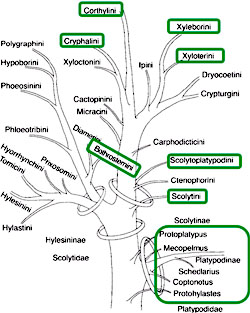Meet the Beetles: Classification (2009)

Fig: The many independent origins of ambrosia feeding highlighted on a classification of scolytine and platypodine beetles by S. L. Wood (Wood, 2007). The tree is not from a phylogenetic analysis, but it’s the most widely accepted classification.
Ambrosia beetles are not a monophyletic group. They are a set of independently evolved fungus-farming clades within weevils (Curculionidae). The strategy of farming fungus has evolved many times in multiple saprophagous bark beetle and weevil groups. For the best treatment on their evolution see Farrell et al. (2001). Three of these fungus-farming groups diversified tremendously: the tribes Xyleborini and Corthylina, and the subfamily Platypodinae. The naming scheme of these groups is currently in flux, the most authoritative classification of genera is by Alonzo-Zarazaga & Lyal (2009).
The following groups of scolytine and platypodine beetles contain at least some ambrosia species: Platypodinae, Xyleborini, Corthylina, Xyloterini, Scolytoplatypodini, Premnobiini, Scolytini (Camptocerus), Cryphalini (several tropical Hypothenemus), Bothrosternini (some Eupagiocerus), Hyorrhynchini (Sueus), Ctenophorini (Scolytodes unipunctatus), and probably others. There are a number of other beetles which rely heavily on their fungal symbionts, such as Dendroctonus frontalis, but they are mostly considered phloem-feeding bark beetles. Other bark beetles are strictly fungivorous, but are dependent on finding their fungal food in the environment, rather than carrying it with them as a symbiont. An example is Trischidias exigua (Cryphalini)(Deyrup, 1987).

Fig: Some uncommon groups of ambrosia beetles. Left to right: Camptocerus anaepennis (Scolytini), ambrosial Hypothenemus sp. (Cryphalini), Scolytoplatypus papuanus (Scolytoplatypodini), Treptoplatypus solidus (Platypodinae). Photos Sarah Smith (1), J.H. (2-4).
One of the most rapidly diversifying, most widely distributed, and probably most ecologically and economically significant group of ambrosia beetles is the tribe Xyleborini. Biologically, this group is clearly defined by the combination of a haplodiploid genetic system in which males are haploid, flightless and often dwarfed, extreme inbreeding, and obligate ambrosial habit. Although these biological features are found elsewhere in Scolytinae, their combined occurrence in Xyleborini is unique. These biological features are also hypothesized to have been the cause of a rapid radiation that has produced nearly 1,400 species since the early Oligocene (Jordal et al., 2000). Both the rapid diversification and the inbreeding are probable causes of unclear species limits and a relative lack of clearly definable morphological characters.
The new age of ambrosia research (2017)
It was nearly a decade ago when we wrote the text above. Since then, the ambrosia symbiosis research community has exploded (there is at least one paper published on this each week). Our own team at the University of Florida is now so big that it’s difficult for one person to stay up to date on all of our individual projects. We have discovered several new beetle-fungus mutualisms (including Flavodon and Afroraffaelea), fully embraced genomic tools, amassed the largest collection of cryopreserved ambrosia beetles, and redefined the whole symbiotic system: there is not one, but many ambrosia symbioses. We wrote a review of the current knowledge of the system. The review included the picture below – a cartoonish summary of what we know about the diversity and identity of ambrosia beetles. Feel free to download it and use it but don’t get too attached to it, because Dr. Andrew Johnson is already remaking the scolytine phylogeny.

Ambrosia beetle diversity. The yellow shapes indicate mycangia.
References
Deyrup, M. (1987) Trischidias exigua Wood, new to the United States, with notes on the biology of the genus. Coleopterist Bulletin, 41, 339-343.
Farrell, B.D., Sequeira, A.S.O., Meara, B.C., Normark, B.B., Chung, J.H., & Jordal, B.H. (2001) The evolution if agriculture in beetles (Curculionidae: Scolytinae and Platypodinae). Evolution, 55, 2011-2027.
Jordal, B.H. (2002) Elongation Factor-1a resolves the monophyly of the haplodiploid ambrosia beetles Xyleborini (Coleoptera: Curculionidae). Molecular Insect Biology, 11, 453-465.
Wood, S. L. (2007) Bark and Ambrosia Beetles of South America (Coleoptera: Scolytidae). Monte L. Bean Life Science Museum, Brigham Young University, Provo, UT, 900 pp.
